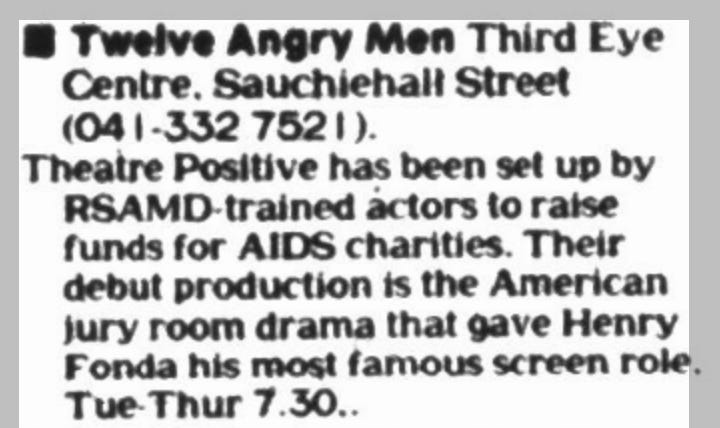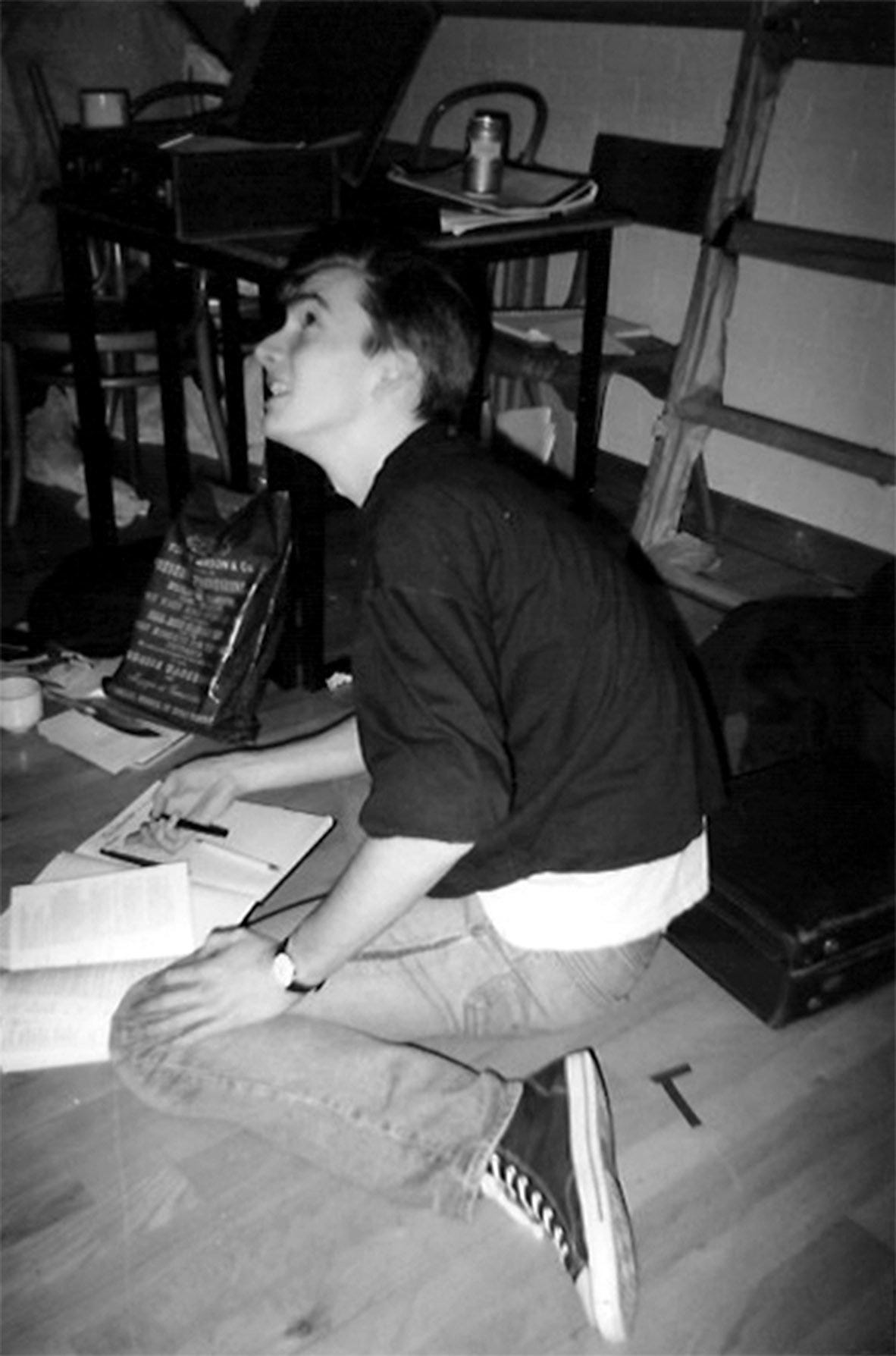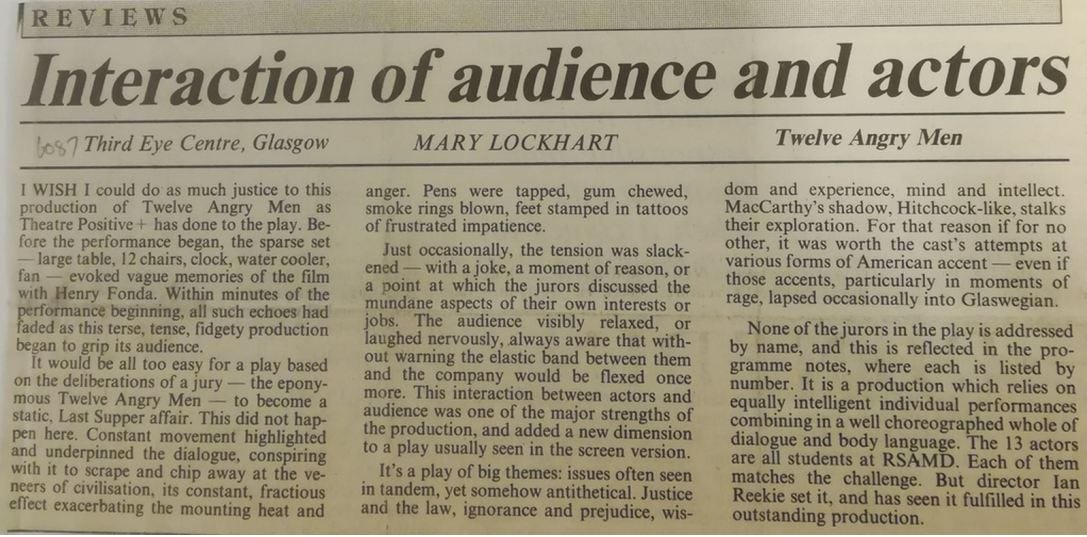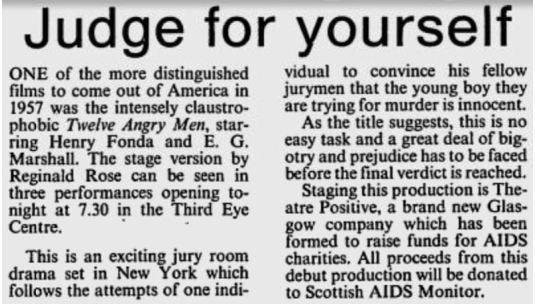Early Theatre Deep Dive Pt 1: David Tennant in 'Twelve Angry Men' (1990)
...and his performances at the Third Eye Centre (now the CCA)
Before I begin my three-part series on a young David Tennant’s role in Twelve Angry Men, I want to make a few things clear: first, the production was very well-received by critics and theatregoers alike, and second, it likely played a pivotal role in David’s future career. Other than the fact Twelve Angry Men is pure brilliance, I think these two things also helped contribute to David’s great regard for the piece and why he’s mentioned it in a number of interviews he’s done over the years. During a 2007 interview for the RSAMD's Academy magazine, David said Twelve Angry Men was his favorite movie. And in an interview for Doctor Who Magazine, he was asked what film remake he would like to star in. Once again, he chose Twelve Angry Men.
A courtroom drama written by Reginald Rose, Twelve Angry Men focuses on the twelve-man jury of a murder trial and their deliberations to reach a verdict. It was initially broadcast on CBS in 1954 as a live television play on an anthology series called Westinghouse Studio One. It was adapted for the stage in 1955, and a rewritten version was adapted for the silver screen in 1957. Starring Henry Fonda as Juror #8, the film was nominated for three Academy Awards. It’s also consistently rated as one of IMDb’s top five films of all time.
Filmsite.org gives an excellent summary (which I’ll mostly quote, with a bit of paraphrasing here and there):
Twelve Angry Men is an examination of a group of twelve jurors with different personality types (but who are all male, mostly middle-aged, white, and generally middle-class) who are uncomfortably brought together to deliberate after hearing the “facts” in a seemingly open-and-shut murder trial case.
The jury - entrusted with the power to send an poor and uneducated teenage Hispanic boy to the electric chair for killing his father with a switchblade knife - are literally locked into a small, claustrophobic, rectangular jury room on a stifling hot summer day, until they come up with a unanimous decision - either guilty or not guilty.
Fortunately, one brave dissenting juror votes “not guilty” at the start of the deliberations because of his reasonable doubt. Persistently and persuasively, he forces the other men to slowly reconsider and review the shaky case against the defendant. He also chastises the system for giving the unfortunate defendant an inept “court-appointed” public defense lawyer who inadequately cross-examined the witnesses. Heated discussions, the formation of alliances, the frequent re-evaluation and changing of opinions, votes and certainties, and the revelation of personal experiences, insults and outbursts fill the jury room.
The play is a powerful indictment, denouncement and expose of the trial by jury system. The teenage defendant is on trial, sure, but so is the jury, and the American judicial system itself - with all of its purported sense of infallibility, fairness and lack of bias.
It’s a heavy-hitting play which goes deep, exposing the juror’s deep-seated personal prejudices. It brings out their biases and weaknesses, and exposes the ignorance and fear which threaten to taint their decision-making abilities. And it highlights how one man can stand against the tide and make a difference.
If all of this makes you want to see the film, you should (and if you’re into this sort of thing, you can find in-depth analyses of the play and its film adaptation all over the Internet). First, there’s this transcript of the Reginald Rose Teleplay. And here’s the original 1954 live TV broadcast from the adaptation by Reginald Rose:
—
Now that we know what Twelve Angry Men is all about, we’re ready to dive into David’s performances of the piece.
Twelve Angry Men is listed once - and once only - on David’s Wikipedia page under the ‘Stage’ subheading:

However - this listing is only partially accurate!
The source given for this listing is a review of the production at the Arches Theatre in Glasgow, printed in the Glasgow Herald on 14 July 1990 (“Positive side of Twelve Angry Men”). And while it is an accurate source, what it leaves out is the fact that these July dates were not the production’s first run. They were its second run!
You see, Twelve Angry Men was performed a total of three times. The play’s actual first run - in April 1990 at the Third Eye Centre (now the Centre for Contemporary Arts) in Glasgow - was a dry run taken on in preparation for the main run at the Arches Theatre in Glasgow. Three months later, in July 1990, the play’s second run at the Arches began. Both runs were wildly successful.
And that was that - or so it seemed.
About six months later, an opportunity came up for them to do another short run at the Cumbernauld Arts Theatre in Cumbernauld (a large town in North Lanarkshire, smack dab in the center of Scotland’s Central Belt). And even though it had been so long since they’d done the last shows that they had to re-rehearse the play, they decided to go ahead with it and did three dates in Cumbernauld in April 1991.
-
For this three-part feature on all the runs of Twelve Angry Men, I’ve been privileged to talk to a teacher of David’s who attended one of the play’s performances, and three of the actors who auditioned and won a part in the production. All the actors worked alongside David in other productions during their years at the RSAMD, and one worked with him a few years afterwards on other productions, too.
The first of these three actors is Sam Ellis. Ellis not only played the role of the Foreman in Twelve Angry Men, he also had a small role as a photojournalist in Takin' Over The Asylum! Remember how David chose the name ‘Tennant’ because there was already a David McDonald in Equity, the Actor’s Union? Well, the same thing happened to Ellis. Although he enrolled in the RSAMD under his real name, Robert Ellis, he chose the stage name Robert Ellison (which was the name he used in Twelve Angry Men). Ellis changed his name to Sam Ellis in 1994, and under that name he’s worked for decades on stage and screen as an actor and director. He’s most well-known for his role as Private Hastings in Saving Private Ryan. He’s currently a Senior Lecturer at Bath Spa University in Bath, England, where he teaches on the undergraduate BA Honors Acting programme.
The second actor I’ve spoken to is Ashley Collishaw. In Twelve Angry Men, Ashley played the role of Juror #5. He took a few roles a couple years after he left drama school - he was in the BBC Channel 5 TV movie Hospital!, the BAFTA-nominated legal drama series Wing and a Prayer, and the ITV series Babes In The Wood. But soon thereafter, he chose to leave the industry altogether. He’s currently a Reverend in the Anglican church.
The third actor I’ve spoken to about Twelve Angry Men is Stephen Hogan, who played the role of the Guard. The role was his first job on a professional stage, as at the time he was a first year DDA student (which put him a year behind David). After he graduated, he went on to take a role in ITV’s beloved Scottish soap opera Take The High Road before going on to play leading roles in numerous plays across the UK and Ireland. He performed at the Royal National Theatre in London and the prestigious Abbey and Gate Theatres in Dublin. His television roles include Sir Henry Norris in The Tudors, and supporting and guest lead roles on the BBC series Injustice and the ITV series Primeval. His movie roles include Renfield in Dracula: The Dark Prince and Sky Marshal Anoke in Starship Troopers 3: Marauder. Beyond that, he’s a prolific audiobook narrator and voice actor. He also worked with David at the Dundee Rep in the 1992 play Shinda and the Magic Ape, and the 1993 play Princess and the Goblin.
Lastly, I spoke to Peter McAllister, who was a Lecturer in Acting and Direction at the RSAMD. He directed David in the student play The Matchgirls, and was the teacher/chaperone for a school exchange visit David took to Warsaw, Poland. He went to see Twelve Angry Men during its first run at the Third Eye Centre.
All four of these men were kind enough to share some of their memories of their experiences in Twelve Angry Men with me. I’ll be leaning on their recollections heavily throughout this series in order to reconstruct as much as I can of all three runs of Twelve Angry Men.
-
Today’s post will focus on the play’s first April 1990 “dry” run, the one before they set foot in the Arches Theatre three months later.
We begin our story in the spring of 1990, when David was a Second Year drama student at the RSAMD (Royal Scottish Academy of Music and Drama, now the Royal Conservatoire). He was incredibly busy - besides classes, since January of that year he'd done productions of Neil Simon's Fools, The Good Companions (a musical based on Ronald Harwood's book of the same name), Enemies by Maxim Gorky, The Matchgirls by Bill Owen and Tony Russell, and The Street by his good friend Alan McHugh. (As an aside: if you’re a sharp-eyed DT fan, you’ll have noticed all but one of the productions I’ve just mentioned are not listed on David’s Wikipedia page! But never fear - I’ll get into deeper dives of all of them eventually).
By March 1990, most of these productions had been wrapped up. But there was one more production David had yet to do burbling along the pipeline: Twelve Angry Men.
The RSAMD’s version of Twelve Angry Men began with the establishment of a brand new Glasgow-based theatre company made up of former and current RSAMD students called Theatre Positive+ Scotland. Formed as a fund-raising project for AIDS charities, it was the company’s intent to stage Twelve Angry Men as its first production. All the proceeds from Twelve Angry Men were donated to Scottish AIDS Monitor (SAM).
SAM had been founded in Edinburgh in 1983 by Derek Ogg after he’d read a newspaper report about a mysterious illness affecting gay men in the US. Even before the first case was confirmed in Scotland, SAM had already been organized by Ogg and some friends of his who were consultants in sexual health. Their aim was to prepare people well in advance by providing information and awareness of the new disease, and education to help them protect themselves. The organization was funded through private donations and public funding.

The two founders of Theatre Positive+ Scotland were Iain Reekie and Steven Leach. Reekie was a 1989 graduate from the RSAMD, and Leach was in David’s year in his BA class in Dramatic Studies. They put a call out around the RSAMD for anyone else who might be interested in the project, and then met with everyone to talk casting and conduct auditions.
Reekie and Leach knew they wanted to do Twelve Angry Men, and they had ideas about how they wanted it to take shape. Reekie would direct and Leach would play a juror. American accents were a given - as the play was American in origin - and they would adapt the original play’s sparse staging as well.
Reekie also decided he would ask Pete D'Souza (a lecturer at the RSAMD who was a bit of a favorite of the students) to record a tape of the Judge’s words they could play off tape at the performances. D’Souza was very supportive of the production, so he readily agreed. And of course, they would also have to choose a venue for the dry run performances they planned to do over the Easter break before their run at the Arches.
David was one of the students to go along when that call came out, and he won the role of Juror #8 (though not at first - apparently he was Juror #4 until the original Juror #8, Tom Smith, dropped out! - for more info, see the ETA note at the bottom of this post). It was a coveted role - considered the protagonist and the Juror who stood against everyone, the role was the one played by Henry Fonda in the 1957 movie version.
The other actors to secure a role in the production were Robert Ellison (now Sam Ellis) as the Foreman, Steven Leach as Juror #2, Tom McGovern as Juror #3, William Leslie as Juror #4, Ashley Collishaw as Juror #5, Simon Crowther as Juror #6, Alan McHugh as Juror #7, Cathal Quinn as Juror #9, James Ryan as Juror #10, Scott Cleverdon as Juror #11, Greg Wise as Juror #12, Pete D'Souza as the voice of the Judge (recorded), and Stephen Hogan as the Guard (a tiny role which appears at the very start and very end of the play).
With the cast chosen, they got down to rehearsals. Collishaw told me they “rehearsed in a few places, whatever we could use, as we were doing it on the cheap.” This was because, while all the actors in the production were students at the RSAMD, the drama school itself was not directly sponsoring the show. They did manage to get some rehearsals in studios on the RSAMD campus, but they also had to scramble to find other venues.
Ashley Collishaw also kindly provided me with a photo of a young David Tennant taken during a rehearsal for an unknown student production. He wasn’t sure which production, but said he believed it was taken around 1990.
Now keep in mind this is merely an educated guess on my part and is in no way confirmed…but given Collishaw took the photo and only did two other plays with David from 1990 through the first part of 1991, I think there’s a reasonable chance it could be a photo of David in rehearsal for any of the three production runs of Twelve Angry Men. (And if anyone actually knows what’s this from and can set me straight, please comment at the end of this post and let me know!)

Twelve Angry Men premiered at 7:30 pm on Tuesday, 24 April 1990 in a small studio at the Third Eye Centre in Glasgow’s Sauchiehall Street, a venue now known as the CCA, the Centre For Contemporary Arts. An arts centre cafe/restaurant, The Third Eye probably held about 150 people.
It played for a total of three nights, and closed on Thursday, 26 April 1990.
We’ll go on with the story in just a moment, but first? A little bit of history about The Third Eye Centre.
The Third Eye Centre was founded in 1974 by Scottish writer and playwright Tom McGrath, and he became its first Artistic Director. McGrath was a well-known figure in the beat-poet underground culture of Glasgow, and he hung around with guys like Allan Ginsberg and R. D. Laing - yeah, that R. D. Laing!
Anyway, the Third Eye was where you went if you wanted to see innovation or off-the-wall sorts of programming, and it was described by the Guardian as ‘a shrine to the avant-garde'. It was the leading center for contemporary visual and performing arts in Glasgow, and quickly became the focus for the city’s counter culture.

When David and the rest of Theatre Positive Scotland rolled up to perform Twelve Angry Men there, the Third Eye only had a little over a year left before it would fold. It would close in August of 1991 and reopen again in April 1992, with a new name (the Centre For Contemporary Arts) and a new Artistic Director.
I’m sad to say I don’t have a programme from Twelve Angry Men’s Third Eye Centre run (as a matter of fact, I’m not even sure they printed one!) Of the three runs, this first “dry run” set of dates is the only one for which I don’t have a programme.
The reaction the play received was stellar. Mary Lockhart of the Glasgow Herald wrote a rave review, calling the production “outstanding” and “terse, tense, [and] fidgety”. She noted the interactions between the actors and the audience was a major strength of the show. Really, she was impressed!
You just have to read it in full:

Peter McAllister, the RSAMD lecturer who went to see the play at the Third Eye, told me he went along to see it because many of his former or present students were in it. “It was a powerful production, and launched the directing career of the future artistic director of 7:84 Theatre Company,” he said. “I don't remember much else, except it was a very small studio.”
Small venue though it was, Twelve Angry Men definitely generated some buzz. According to the article below, it raised over £500 for Scottish AIDS Monitor over its three-day run! It was such a success, the cast booked another run (at the Arches, though it didn’t specify in the article) for July.
Speaking of that £500 - I wasn’t able to find out exactly how much tickets were for this run of the play. But if I were to use the ticket prices of the Arches run (which ran anywhere from £2-£3 for concessions and £4-£5 for regular admission) and the seating capacity of the Third Eye Centre as a base for comparison - factoring in a deduction of about 50 seats a night for comps? Anywhere from £600 to £1500 could have been raised. Since the article above didn’t mention the figure went above 1K, though, I imagine they hit between £500-£1000. Not bad for a student production!
Before I close, I’d just like to point out something Peter McAllister mentioned above: that this production helped to launch the directing career of the future Artistic Director of the 7:84 Theatre Company.
Keep this in mind. By the end of this series, I’ll have some closing words to say about the significance of Twelve Angry Men…not only to the career of its director, Iain Reekie, but about what I mentioned in the first paragraph of this piece: I believe it also helped put events in motion with regards to David’s career.
Next time — we explore Twelve Angry Men’s July 1990 run at the Arches Theatre in Glasgow!
-
ETA: It’s been brought to my attention from @elsinore-and-inverness on Tumblr that in his recent 13 March 2025 appearance at St. Alban’s Church in Chiswick with podcaster Deborah Frances-White (which benefited the Upper Room, a charity which provides meals and support for homeless and vulnerable people in West London), David himself mentioned his work on Twelve Angry Men! David said he was originally cast as Juror #4, but got promoted to Juror #8 because the original Juror #8, Tom Smith (who played the werewolf in the Doctor Who episode “Tooth and Claw”), got sick and had to drop out. Thanks to elsinore-and-inverness for giving me this information!








love it and love his earnest look in the photo, thank you.